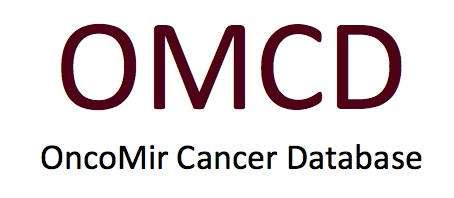OncoMir Cancer Database (OMCD)
Frequently Asked Questions
Q- What is included in this database?
In the current version (1.0) the OMCD database includes miRNA profiling data from 9619 samples representing 33 different tumor datasets and corresponding normal tissues wherever available.
Q- Can I download the data to my local computer?
The database in this format is copyrighted to University of Minnesota. Requests for permission to download a non-trivial percentage of the OMCD data should be emailed to sarver@umn.edu. Users can download the original underlying data directly from TCGA, please note that TCGA places additional restrictions on use of this data and these restrictions, particularly publication restrictions, carry through to this database. Additional information is also available for download directly from TCGA, for example survival outcome and other clinical information, and more information is available on the TCGA site.
https://tcga-data.nci.nih.gov/tcga/tcgaDownload.jsp
Q- What does the average ratio represent?
The average ratio for a statistical result is generated by the division of the average expression value of the tumor of interest by the average of the comparison of the other group. For example a ratio of 10 in a Normal Tumor comparison would mean that the average of the tumor group was ten fold higher than the average of the normal control group. Conversely a ration of 0.1 would mean that the tumor group had ten fold lower average expressionlevel than the average of the normal control group.
Q- Why do some queries return a blank page or error?
If data is not available within the database for a given miRNA a blank page is returned.
Q- How is the data normalized?
The data is provided in reads per million miRNA mapped.
Q- What statistical parameters are set as default?
We suggest the usage of Bonferroni corrected P values and suggest examination of large ratio changes. The user is also encouraged to examine miRNA that make up larger percentages of the population and have higher read per million values.
Q- Will you be adding the associated mRNA data?
Yes! We are currently working on including the corresponding TCGA mRNA RNA-Seq data and plan to include these data in the next release.
Q- Why was miRDB selected for finding miRNA targets?
There are a number of excellent target prediction databases and we selected miRDB as an example of high quality target predictions. For more information on miRDB please consult their source publication at Nucleic Acids Research. 43(D1):D146-152.
Q- What statistics are used to generate the statistics view?
The results shown in the statistics view are the results provided for a two group t-test comparing the stated tissue with the remaining tissue types selected for specific analysis.
Q- Is there a potential for batch affects to be interpreted as differential expression in the advanced search results?
Yes, TCGA miRNA expression data is generated at different centers/ institutes and at different time points so the user is hereby warned.
Q- What version of human genome data is used to show the nucleotide position of miRNAs?
HG19
Q- I don't see my favorite miRNA?
We have used all the expression data provided by the TCGA and listed all the miRNAs in that dataset. Some recently identified novel miRNAs or any predicted miRNAs may not be available in this dataset.
Q- How do I read the TCGA barcode?
Please use this URL link for more details: https://wiki.nci.nih.gov/display/TCGA/TCGA+barcode
Q- Is there a provision for selecting matched normal?
Please see the bar code data for selecting such cases.
Q- I have some suggestion or comments regarding your database. Who do I contact?
Please send your suggestions to sarver@umn.edu.
Q- I have some data I would like to include in your database what should I do?
Contact us and we will consider it on a case by case basis.
Q - Who should I contact regarding the contents of this database?
Dr. Aaron Sarver
Masonic Cancer Center
University of Minnesota
sarver@umn.edu
©2015 Masonic Cancer Center Biostatistics and Informatics
Home
FAQ
website designed and maintained by Aaron Sarver Ph.D.
Hosted by the Minnesota Supercomputing Institute



